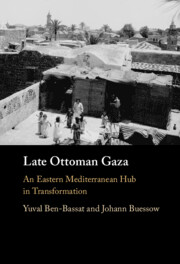Book contents
- Late Ottoman Gaza
- Late Ottoman Gaza
- Copyright page
- Dedication
- Contents
- Figures
- Acknowledgments
- Notes on Transcription and Dating
- Introduction
- 1 A Bird’s-Eye View of Gaza’s Economy, Population, and Geostrategic Position
- 2 Living in Late Ottoman Gaza
- 3 Relationships with the Rural Population
- 4 Gaza-Style Politics and the Emergence of Spatialized Factionalism
- Conclusion
- Bibliography
- Index
1 - A Bird’s-Eye View of Gaza’s Economy, Population, and Geostrategic Position
Published online by Cambridge University Press: 07 November 2024
- Late Ottoman Gaza
- Late Ottoman Gaza
- Copyright page
- Dedication
- Contents
- Figures
- Acknowledgments
- Notes on Transcription and Dating
- Introduction
- 1 A Bird’s-Eye View of Gaza’s Economy, Population, and Geostrategic Position
- 2 Living in Late Ottoman Gaza
- 3 Relationships with the Rural Population
- 4 Gaza-Style Politics and the Emergence of Spatialized Factionalism
- Conclusion
- Bibliography
- Index
Summary
This chapter analyzes the major trends in late Ottoman Gaza’s economy, society, and geostrategic importance. It tackles the misconception that during this period Gaza was a city in “decline.” It discusses a wide range of topics such as the impact of early globalization and the change in the hajj pilgrimage route on the status of Gaza as a caravan city; the impact of the barley boom in the Northern Negev between 1890 and 1910 as a result of the growing demand of Britain’s beer industry on Gaza’s economy; the city’s lack of a proper port infrastructure and its implications; the Ottoman government state-building measures and division of the region’s administrative borders, the establishment of Beersheba to reduce Gaza’s influence on the Bedouins of the Negev, and the governmental development plans envisioned for the Gaza region; the extensive relationships between Gaza and Egypt, including the effects of the occupation of Egypt by Britain in 1882 and the creation of the administrate dividing line between Egypt and Palestine in 1906 on Gaza’s geostrategic importance. Finally, it explores whether the Young Turk Revolution of 1908 constituted a turning point in Gaza’s importance in the eyes of the central government and how it affected the city’s development.
Keywords
- Type
- Chapter
- Information
- Late Ottoman GazaAn Eastern Mediterranean Hub in Transformation, pp. 34 - 64Publisher: Cambridge University PressPrint publication year: 2024

